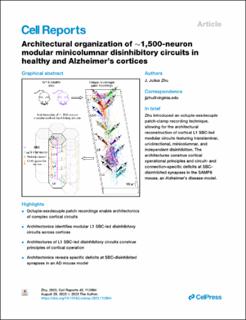| dc.contributor.author | Zhu, J. Julius | |
| dc.date.accessioned | 2023-12-14T08:02:29Z | |
| dc.date.available | 2023-12-14T08:02:29Z | |
| dc.date.created | 2023-08-24T09:11:34Z | |
| dc.date.issued | 2023 | |
| dc.identifier.citation | Cell reports. 2023, 42 (8), . | en_US |
| dc.identifier.issn | 2211-1247 | |
| dc.identifier.uri | https://hdl.handle.net/11250/3107474 | |
| dc.description.abstract | Acquisition of neuronal circuit architectures, central to understanding brain function and dysfunction, remains prohibitively challenging. Here I report the development of a simultaneous and sequential octuple-sexdecuple whole-cell patch-clamp recording system that enables architectural reconstruction of complex cortical circuits. The method unveils the canonical layer 1 single bouquet cell (SBC)-led disinhibitory neuronal circuits across the mouse somatosensory, motor, prefrontal, and medial entorhinal cortices. The ∼1,500-neuron modular circuits feature the translaminar, unidirectional, minicolumnar, and independent disinhibition and optimize cortical complexity, subtlety, plasticity, variation, and redundancy. Moreover, architectural reconstruction uncovers age-dependent deficits at SBC-disinhibited synapses in the senescence-accelerated mouse prone 8, an animal model of Alzheimer’s disease. The deficits exhibit the characteristic Alzheimer’s-like cortical spread and correlation with cognitive impairments. These findings decrypt operations of the elementary processing units in healthy and Alzheimer’s mouse cortices and validate the efficacy of octuple-sexdecuple patch-clamp recordings for architectural reconstruction of complex neuronal circuits. | en_US |
| dc.language.iso | eng | en_US |
| dc.publisher | Elsevier | en_US |
| dc.rights | Attribution-NonCommercial-NoDerivatives 4.0 Internasjonal | * |
| dc.rights.uri | http://creativecommons.org/licenses/by-nc-nd/4.0/deed.no | * |
| dc.title | Architectural organization of ∼1,500-neuron modular minicolumnar disinhibitory circuits in healthy and Alzheimer's cortices | en_US |
| dc.title.alternative | Architectural organization of ∼1,500-neuron modular minicolumnar disinhibitory circuits in healthy and Alzheimer's cortices | en_US |
| dc.type | Peer reviewed | en_US |
| dc.type | Journal article | en_US |
| dc.description.version | publishedVersion | en_US |
| dc.source.pagenumber | 0 | en_US |
| dc.source.volume | 42 | en_US |
| dc.source.journal | Cell reports | en_US |
| dc.source.issue | 8 | en_US |
| dc.identifier.doi | 10.1016/j.celrep.2023.112904 | |
| dc.identifier.cristin | 2169197 | |
| cristin.ispublished | true | |
| cristin.fulltext | original | |
| cristin.qualitycode | 2 | |

